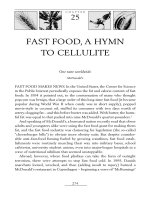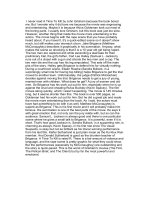FAST FOOD, A HYMN TO CELLULITE
Bạn đang xem bản rút gọn của tài liệu. Xem và tải ngay bản đầy đủ của tài liệu tại đây (169.8 KB, 11 trang )
274
CHAPTER
25
FAST FOOD, A HYMN
TO CELLULITE
One taste worldwide.
McDonald’s
FAST FOOD MAKES NEWS. In the United States, the Center for Science
in the Public Interest periodically exposes the fat and calorie content of fast
foods. In 1994 it pointed out, to the consternation of many who thought
popcorn was benign, that a large order of this long-time fast food (it became
popular during World War II when candy was in short supply), popped
movie-style in coconut oil, stuffed its consumer with two days worth of
artery-clogging fat – and this before butter was added. With butter, the harm-
ful fat was equal to that packed into nine McDonald’s quarter-pounders.
1
And speaking of McDonald’s, a bemused nation recently read that obese
adults and youngsters alike were suing the fast food giant for making them
fat, and the fast food industry was clamoring for legislation (the so-called
“cheeseburger bills”) to obviate more obesity suits. But despite consider-
able anti–fast-food fuming fueled by growing waistlines, fast food estab-
lishments were routinely muscling their way into military bases, school
cafeterias, university student unions, even into major-league hospitals in a
wave of nutritional nihilism that seemed unstoppable.
Abroad, however, where food phobias can take the form of outright
terrorism, there were attempts to stop fast food cold. In 1995, Danish
anarchists looted, wrecked, and then (adding insult to injury) burned a
McDonald’s restaurant in Copenhagen – beginning a wave of “McBurnings”
Fast Food, a Hymn to Cellulite
275
and “McBombings” that stretched in Europe from Belgium and England
to Greece, France, and Russia, and in South America from Cali to Rio de
Janeiro.
2
Why? One of the reasons is that hamburgers have come to sym-
bolize U.S. modernity and effi ciency to many of the young, and a global
imperialism to others, including their wary elders.
Fortunately, foreign protest is not always violent and, in fact, can be mani-
fested as gentle mockery. Look, for example, at the “Slow Food Movement,”
an advocacy organization based in Italy that emphasizes local and regional
cuisine, rejects food homogeneity, and insists on lengthy cooking times.
The movement, which began in 1986 as a protest against the opening of a
McDonald’s restaurant in Rome, now counts over 65,000 members in close
to 50 countries.
The current fast food fuss obscures the reality that such foods are
ancient. Fried kibbeh, sausages, olives, nuts, small pizzas, and fl at breads
have been sold on the streets of Middle Eastern and North African cit-
ies for a cycle of centuries; Marco Polo reported barbequed meats, deep-
fried delicacies, and even roast lamb for sale in Chinese markets. Specialty
shops and stalls featuring noodles, sushi, and tempura were ubiquitous in
downtown Edo (now Tokyo) as early as the eighteenth century. In 1762,
John Montagu was gambling at London’s Beefsteak Club and did not want
to waste time sitting down to a meal; so he slapped bread slices around
a hunk of meat (fortunately Montagu was the fourth Earl of Sandwich,
otherwise we might be calling this fast food a Montagu). A bit later fi sh
and chip shops began opening in London, representing a marriage of still
other fast foods – fried fi sh, which had been sold on London streets since
the seventeenth century, and chips or French fries, peddled by pushcart
vendors in Paris before the middle of the nineteenth-century.
3
Needless to say, the fries proved polygamous by marrying other foods,
too, in the fast food revolution that radiated out from America in the
century just past. Even the name was changed as the French origin was
either obscured or ignored. They became known as “American fries” in
many countries – an appropriate name given the potato’s origin – and
briefl y “freedom fries” in the United States to express American unhappi-
ness with French objections to “regime change” in Iraq. More American,
however, is the potato chip invented, according to one story, in Saratoga
Springs around the middle of the nineteenth century by a mischievous
chef responding to a customer’s complaint that his French fries were too
thick.
4
276
A Movable Feast
The hamburger, although slower to catch on, proved the most advan-
tageous marriage for French fries. Its origin is blurred, with some insisting
that rounded patties of meat (rissoles) such as the German Frigadelle can be
traced back to the Tartars who tenderized meats by placing them under their
saddles, then ate them raw – the original steak tartare. It was in the seaport of
Hamburg, however, that fried Frigadelle became popular with sailors during
the nineteenth century, hence the name “hamburger” – although in Ham-
burg it is known as “American steak.” The fi rst printed restaurant menu in
the United States – that of Delmonico’s in 1836 – featured the “hamburger
steak” as one of its priciest entrees.
5
The sandwich part of the hamburger began as a fair food. One claim
for its debut is the Outgamie County Fair at Seymour, Wisconsin in 1884,
when a concessionaire is said to have made his hamburger steaks porta-
ble for wandering fairgoers by stuffi ng them between two slices of bread.
Others claim that the innovation came about in Ohio, at the Akron County
Fair in 1892, and, although there are no claims of priority for the St. Louis’
1904 centenary celebration of the Louisiana Purchase, the sandwich, sold
by German immigrants, got considerable exposure there.
6
However, at that same exposition, Pure Food Law advocates and the
Fair’s Pure Food exhibit were telling the public that much of the nation’s
meat contained chemical preservatives (among other things). In the fol-
lowing year Upton Sinclair’s best-selling book The Jungle, exposing meat-
packing malpractices, was published and the public, tortured for years by
an ongoing debate over the safety of the nation’s food supply, now lost its
appetite for meat. Meat sales plunged and its sellers were in trouble.
Their counterattack often exhibited moments of sheer brilliance. Nathan
Handwerker, for example, (who founded Nathan’s Famous Hotdogs in 1916),
hired young men in surgeons smocks with stethoscopes dangling from
their necks to gather round his cart and eat his sandwiches throughout the
day. However, across the nation hot dogs and especially ground beef were
regarded as old, tainted, and defi nitely unsafe to eat. It was this image of
ground beef that White Castle undertook to change in the 1920s by creating
its own atmosphere of purity and cleanliness.
7
Founded in 1921 in Wichita, Kansas at the beginning of the Prohibition
Era, White Castle restaurants joined other “quick service” establishments
like soda fountains, lunch counters (luncheonettes), cafeterias, automats,
and diners to provide cheap alternatives to the now vanished saloon “free
lunches” – often occupying the same space as these recently defunct
Fast Food, a Hymn to Cellulite
277
establishments.
8
Working men and professionals alike straddled stools for
the noon “gobble and git” ceremony.
White Castle elected to concentrate almost exclusively on hamburgers,
ostentatiously made with government-inspected beef, and by mid-decade
had hit on a white enameled exterior and a white porcelain-enamel interior
for their duplicate buildings, which numbered 115 by 1931 – the gleaming
buildings pledging cleanliness inside and out. Imitators, such as the White
Tower, quickly followed with a castle-like structure – and, like the White
Castle outlets, their uniform design doubled as advertising signs.
9
Still other chains, such as the Toddle House and Little Tavern, joined
these early pioneers, and together they elevated the hamburger to respect-
ability in the United States. But because most of these stores were located
downtown in the cities, the hamburger did not yet have a mass market,
and pork remained the most popular meat in America until after World
War II.
The turnaround came in the 1950s with the post-war development
of an automobile-centered culture. The interstate highway system began
spanning the nation, suburbs spilled over from cities, and trend-setting
southern California pioneered in new kinds of fast food restaurants,
including drive-ins. The McDonald brothers, who had entered the drive-
in business in Pasadena just before World War II, began franchising what
had become a self-service restaurant in 1948.
Six years later the now legendary Ray Kroc (then a milk-shake mixer
salesman) persuaded the brothers to let him do the franchising, and his
fi rst store opened in 1956 – a store utilizing the cleanliness principles of its
predecessors. In 1961, he bought out the McDonald brothers and by 1965
had some 700 outlets.
10
But although he learned from the experience of
White Castle and its copycats – most importantly by using uniform struc-
tures as signs (the golden arches) – he had some ideas of his own. White
Castle-type stores were mostly in the inner cities, close to public transpor-
tation, with a workingman clientele. Kroc located McDonald’s restaurants
in the suburbs and along interstate highways – tied to the car and targeting
kids – the baby boomers.
An explosive expansion was accomplished by innovative franchising,
but with enough attached strings that the parent corporation retained
near absolute control. After 1961, franchisees attended the famous “Ham-
burger University” for degrees in “Hamburgerology,” which created a
sort of McDonald’s corporate culture.
11
By 1990, there were some 8,000
278
A Movable Feast
McDonalds eateries (and 30,000 by 2003) whose employees (male only
during the early years) were mostly women, teenagers, and immigrants,
cheap labor that – although paid minimum wages with few or no benefi ts
and hired and fi red as the market dictated – were not likely to organize.
Their tasks were routinized by assembly-line procedures – food Fordism –
that ensured the same meal at any McDonald’s restaurant. Identically-sized
hamburgers were shipped frozen to the outlets; French fries were made
from Russet Burbank potatoes of uniform size and aged the same length
of time to guarantee uniform fl avor.
12
This did not, however, completely
exclude nods to local tastes and cultures. McLobster sandwiches, for exam-
ple, are available in Maine, and the mutton Marharaja Mac is served up in
India, where a prohibition on beef consumption is widespread.
Kentucky Fried Chicken (founded in 1954) employed similar market-
ing methods, along with a host of other hamburger hustlers such as Burger
King (1954) and latecomer Wendy’s (1969). All went after the kids with
ruthless marketing techniques that included playgrounds, toys, cartoon
character watches, contests, and sweepstakes, even ads placed in the schools
and (more recently) on the Internet.
Also competing for the fast food dollar were the ethnic fast food outlets.
Beginning in the 1950s, Italian pizza outlets, spearheaded by Pizza Hut,
Little Caesar’s, and Domino’s, radiated across the nation. They utilized the
same kinds of marketing and assembly-line techniques as the hamburger
chains, as did southern California–born Taco Bell, which blazed a trail in
roadside Mexican food. Its tacos, burritos, chalupas, and nachos introduced
the nation to the tastes of tortillas, cumin, chilli powder, and pinto beans.
Abroad, American fast food found ready acceptance among the young,
even becoming ingrained in youth cultures as exemplifi ed by a group of
Japanese Boy Scouts who, when visiting the United States, were relieved
to fi nd McDonald’s restaurants in Chicago – their anxiety needless since
McDonald’s stores are everywhere and McDonald’s is an Illinois-based
corporation.
13
But – the young aside - as already noted, there have been
violent objections to American fast foods outside of America triggered by
a variety of fears, not the least of which is that globalization in general is
rolling over the world like a juggernaut. Fast food is not only the most vis-
ible manifestation of economic and cultural globalization, it is synonymous
with American cultural imperialism – symbolized by Coca-Cola and by
the golden arches of McDonald’s that announce over 15,000 restaurants
in more than 117 foreign countries.
14









